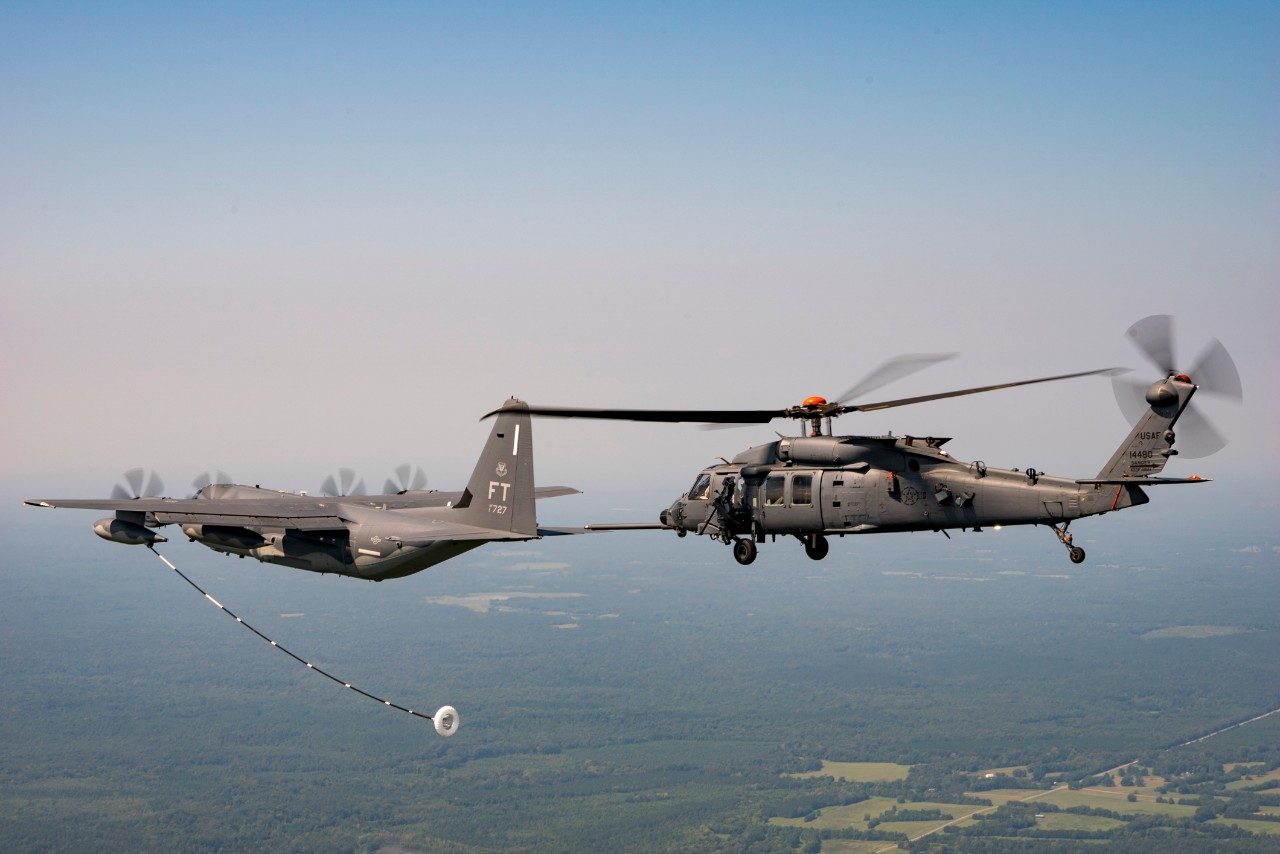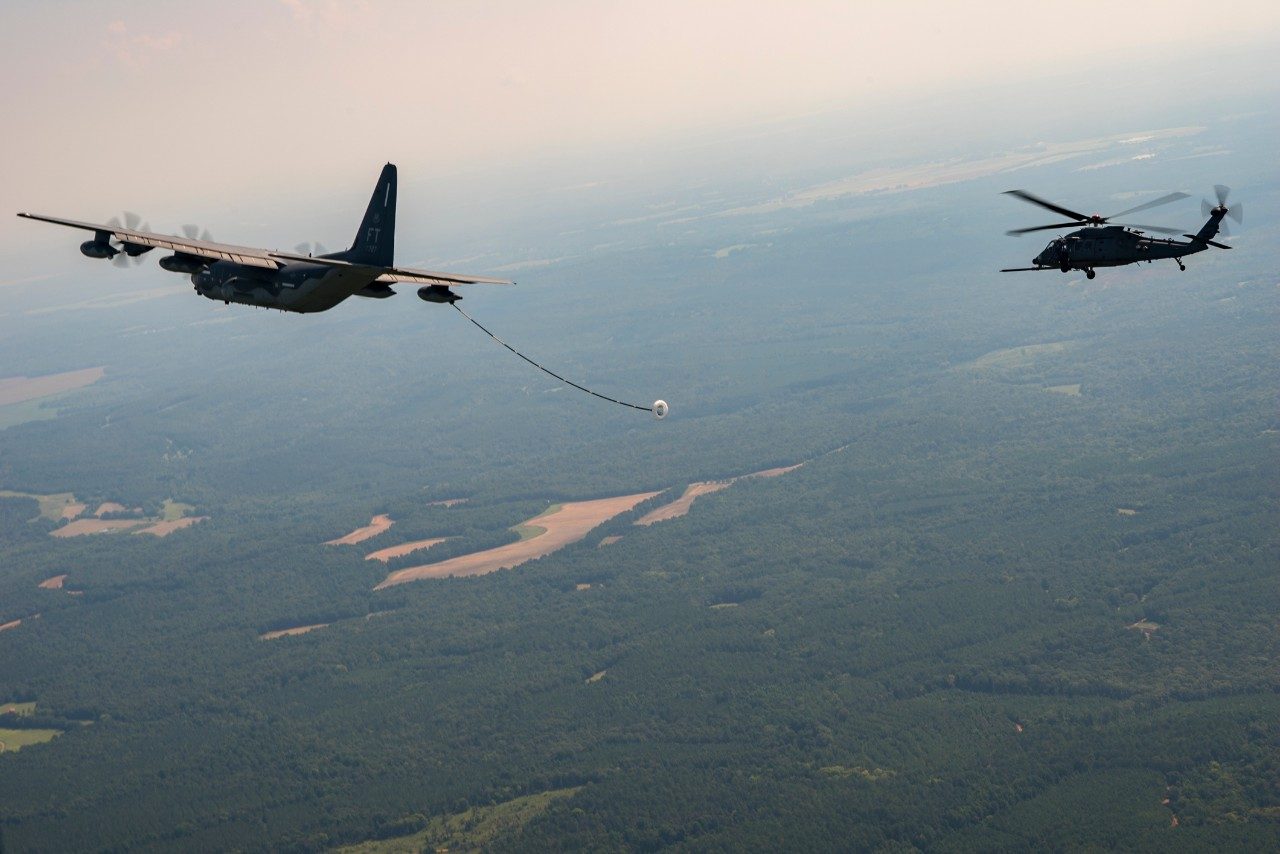Sikorsky’s Combat Rescue Helicopter (CRH) team, in partnership with the U.S. Air Force’s 413th Test Squadron, recently executed a major test event demonstrating the aerial refueling capability of the HH-60W or “Jolly Green II,” which kicked off two weeks of developmental testing of this critical qualification.
The HH-60W connected with a Lockheed Martin HC-130J tanker approximately 3,000 feet above the Eglin Air Force Base range. The aircraft was piloted by both Air Force and Sikorsky pilots and flew at 110 knots to perform the contacts with the tanker. The flight lasted just under two hours.
“The aircraft performed flawlessly during the testing and met all of the program objectives,” said John Biscaino, Sikorsky’s test pilot.
During the testing period the aircrew and engineers evaluated the helicopter’s ability to connect with the fuel drogue and its handling qualities during the fueling. They also monitored the functionality of the systems and gauges to ensure the aircraft received the fuel appropriately with the proper pressures. The pilots flew specific maneuvers that help evaluate the level of difficulty for aerial refueling and identify unforeseen hazards.
“Aerial refueling is essential for the CSAR mission since it greatly extends the operating range of the aircraft and thus allows the unit to extend their rescue capabilities over a larger battlespace,” said Joe Whiteaker, 413th FLTS Combat Rescue Helicopter Flight Chief.
All aerial refueling tests have been successfully executed, completing flight test requirements and meeting all specifications. Early missions were conducted during daylight hours and testing concluded with a nighttime evaluation using night-vision goggles.
“Air-to-air refueling is a decisive force multiplier and proving this capability on the HH-60W significantly increases the range for the Air Force’s new Jolly Green II,” said Greg Hames, Sikorsky CRH Program Director. “This is a critical test milestone for the program as it reinforces the superior capabilities of the HH-60W and its ability to support the Air Force’s combat search and rescue mission. This is my team’s driving force – ensuring we provide the Air Force with all the capabilities it needs to be successful. Your mission is ours.”

Lockheed Martin’s Hercules Teams Up Again with a Sikorsky Helicopter for Another Major Milestone
The battle proven C-130 Hercules, produced by Lockheed Martin Aeronautics, refuels fixed wing, rotary wing and tilt-rotor aircraft as well as conducts rapid ground refueling. The Hercules family of aircraft has served as the standard for tactical refueling for almost 60 years. A U.S. Air Force HC-130J Combat King II was used as part of the HH-60W Combat Rescue Helicopter refueling qualification, a joint effort between Sikorsky and the Air Force. This milestone event follows a similar collaboration between a KC-130J tanker and the CH-53K King Stallion for the heavy lift helicopter’s aerial refueling qualification over the Chesapeake Bay back in April of this year.
A hallmark of Hercules aircraft is their ability to provide AAR to almost every rotary wing platform in the world through its hose and drogue aerial refueling system.
“For many years, legacy HC-130 Hercules and Jolly Green Giant helicopters have supported the U.S. Air Force’s combat and civilian search and rescue missions in a number of complex and trying environments. Both aircraft are legends for many good reasons,” said Rod McLean, vice president and general manager of Aeronautics’ Air Mobility & Maritime Mission line of business. “The HH-60W and the HC-130J represent a new era for the U.S. Air Force, Lockheed Martin and the SAR community. Seeing the HC-130J support the HH-60W in this important refueling qualification milestone offers a glimpse into continuing the successful partnership between these two versatile aircraft for many decades to come.”

Air to Air Refueling: Why it’s Critical to the Mission
The goal of aerial refueling is to extend the range or time an aircraft can remain in the air. Aerial refueling also saves time because the aircraft doesn't have to land to refuel. This also means more lives saved and missions accomplished, a must for the Air Force’s critical rescue mission – often conducted in the harshest and most challenging environments.
The successful execution of the air-to-air refueling test reinforces the superior capabilities of the HH-60W Jolly Green II and its ability to perform long-range missions.
The ability to refuel in midair is essential to the combat search and rescue (CSAR) mission. In order to save downed pilots anywhere, anytime, the HH-60W must be able to travel long distances in the harshest environments. This aerial refueling qualification proves that this aircraft can do just that.
Hames had these final words to say on the successful CRH aerial refueling test: “The execution of this highly visible test event is yet another demonstration of our successful partnership with the Air Force and brings us one step closer to delivering this much-needed helicopter to our men and women in uniform. Thank you to the CRH team, our Air Force colleagues, and all those who supported this effort.”

Changing the CSAR Game
With the exception of the Army Air Corp procurement of the R-4 in the 1940’s, the U.S. Air Force has historically procured helicopters off other services’ contracts with Sikorsky and adapted those helicopters with post-production modifications for their unique mission sets; often at some technical adaptation compromise. The HH-60W is contracted directly between the Air Force and Sikorsky with important Air Force elemental designs being purpose-built into the baseline airframe while maintaining the legacy Black Hawk benchmark survivability and performance features. The unique design approach on HH-60W allowed Sikorsky and the USAF to leverage existing UH-60M advancements and design characteristics that benefit the CSAR mission while enhancing those capabilities with unique mission system enhancements including a new fuel system, armor, weapons, data links, RNP/RNAV, mission processing, sensors, and integrated defensive systems. The final product is a purpose-built, world-wide deployable, CSAR platform, designed to execute within today’s high threat, MDO construct.
The Air Force will procure 113 HH-60W Jolly Green II helicopters to replace its rapidly aging HH-60G Pave Hawk helicopters which have performed non-stop CSAR and personnel recovery operations for all services since 1993. With utilization well beyond the aircraft’s original design, there has been a result of extreme wear and tear on the fleet.
“It is our utmost priority to continue executing this program,” said Greg Hames, Sikorsky’s CRH program director. “Our team works daily to ensure we build and deliver a superior quality and extremely capable helicopter essential to the U.S. Air Force’s CSAR mission.”

CRH Program Progress
The Combat Rescue Helicopter program continues to progress, hitting key milestones and executing an aggressive flight test schedule. The CRH program currently has nine aircraft in flight and has logged over 800 flight hours. Each aircraft is engaged in expanded flight tests to support the path to Required Assets Available (RAA). Additionally, Low Rate Initial Production of CRH Lot 1 aircraft major assembly has begun, with deliveries of the first ten aircraft on track for 2021.
In addition to continued flight test, the program has made significant progress through successful completion of structural loads, climatic, IR signature, and other miscellaneous testing. Defensive system, cybersecurity, mission systems and avionics testing are ongoing. The HH-60W implemented its final planned major software upgrade in June. With aerial refueling underway, the remaining test focus will be on software regression, avionics certification testing, weapons, and final updates to the defensive systems. Additionally, the Live Fire Test & Evaluation program is on track to finish this summer.
Lockheed Martin is also training 200 U.S. Air Force and maintenance aircrew students at our Sikorsky Training Academy in Stuart, Florida, utilizing training systems and three newly built HH-60W aircraft. This will provide flight and maintenance training to initial cadre and units allowing the U.S. Air Force to remain vigilant while simultaneously fielding and employing the added capabilities of the HH-60W aircraft.




